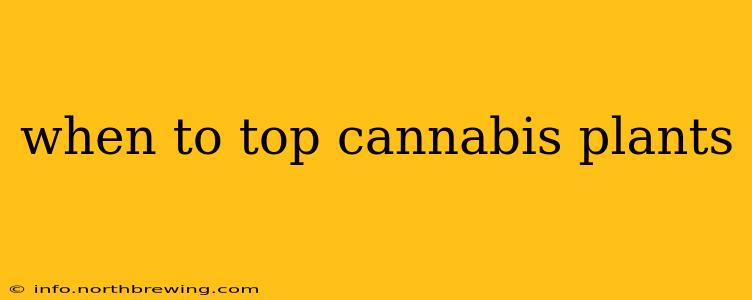Topping cannabis plants is a popular training technique used by growers to increase yields and create bushier, more productive plants. But knowing when to top your cannabis plants is crucial for success. Timing is everything, and improper topping can stunt growth or even damage your plants. This comprehensive guide will explore the optimal time to top, the benefits, potential drawbacks, and answer frequently asked questions to help you make informed decisions for your grow.
What is Topping Cannabis Plants?
Topping involves pinching or cutting the main stem of your cannabis plant just above a node (the point where a branch grows from the stem). This forces the plant to divert energy into the growth of lower branches, creating a bushier structure with multiple main colas (the central flower clusters).
When is the Best Time to Top Cannabis Plants?
The ideal time to top cannabis plants is during the vegetative stage, specifically after your plants have developed 4-6 nodes. This ensures the plant has sufficient energy reserves to recover from the stress of topping and begin branching out. Topping too early can result in stunted growth, while topping too late can reduce overall yield potential.
What happens if I top too early?
Topping too early, before the plant has established a strong root system and enough nodes, can shock the plant and significantly hinder its growth. The plant may struggle to recover and produce fewer buds.
What happens if I top too late?
Topping too late, during the flowering stage, will disrupt the plant's natural flowering process and significantly reduce your overall yield. The energy the plant would have used to develop large, dense buds will instead be diverted to healing the topped area.
How Many Times Can I Top My Cannabis Plants?
The number of times you can top your cannabis plants depends on the strain, its growth rate, and your personal preference. Many growers opt for a single topping, allowing the plant to focus its energy on developing strong branches. Some growers might employ a FIM (Fuc*ing Incredible Method) technique, which is a more precise topping method resulting in multiple branching points. However, excessive topping can stress the plant and potentially harm its development, leading to reduced yields.
What are the benefits of topping cannabis plants?
- Increased Yield: Topping significantly increases the number of flowering sites, ultimately leading to more buds.
- Bushier Plant Structure: Topping promotes a more even canopy, preventing tall, lanky plants. This ensures even light penetration throughout the plant.
- Improved Air Circulation: A bushier plant has better air circulation, reducing the risk of mold and fungal diseases.
- Better Light Penetration: By spreading the plant's structure, you improve the light penetration to all buds, resulting in more uniform and larger flower development.
What are the drawbacks of topping cannabis plants?
- Stress on the Plant: Topping is a stressful procedure for the plant, requiring proper recovery time.
- Reduced Early Growth: Topping can slightly delay the plant's initial growth.
- Potential for Damage: Incorrect topping technique can damage the plant and lead to infections.
Other Training Techniques Besides Topping
While topping is a popular method, other training techniques like LST (Low-Stress Training) and ScrOG (Screen of Green) can also be used to maximize yield and create a more desirable plant structure. These techniques are gentler than topping and can produce excellent results.
Conclusion: Strategic Topping for Optimal Results
Successfully topping your cannabis plants requires careful planning and consideration. Remember to observe your plants closely, choose the right time, and understand the potential benefits and drawbacks. By following these guidelines, you can significantly increase your yields and enjoy a successful harvest. Always remember that each plant is an individual, so careful observation and adjustment are key.
